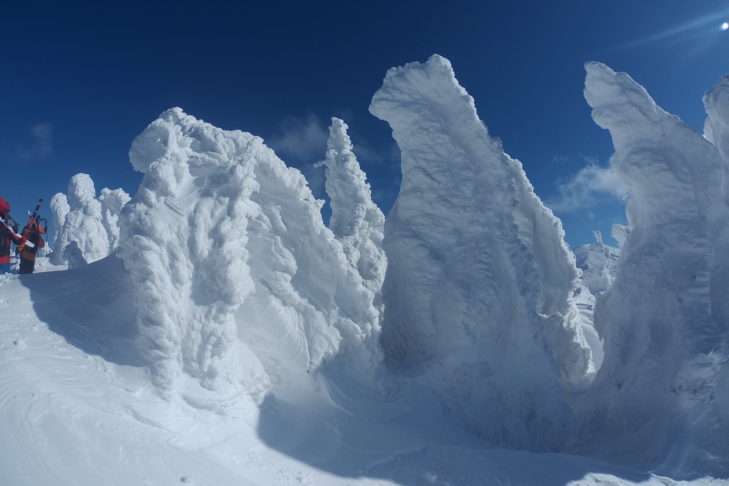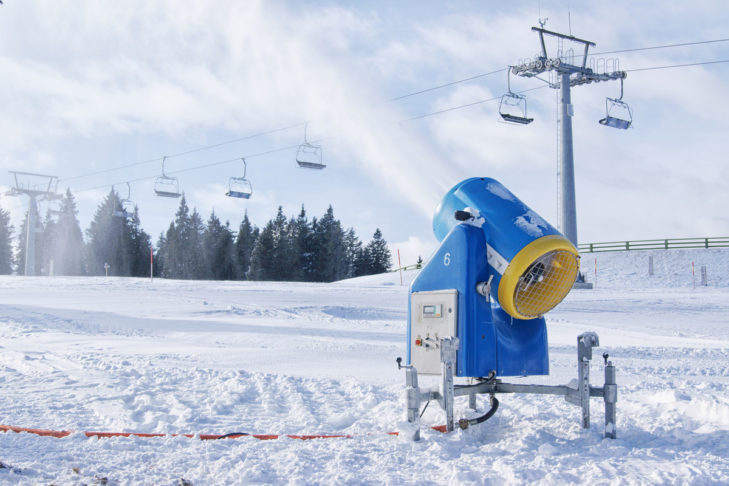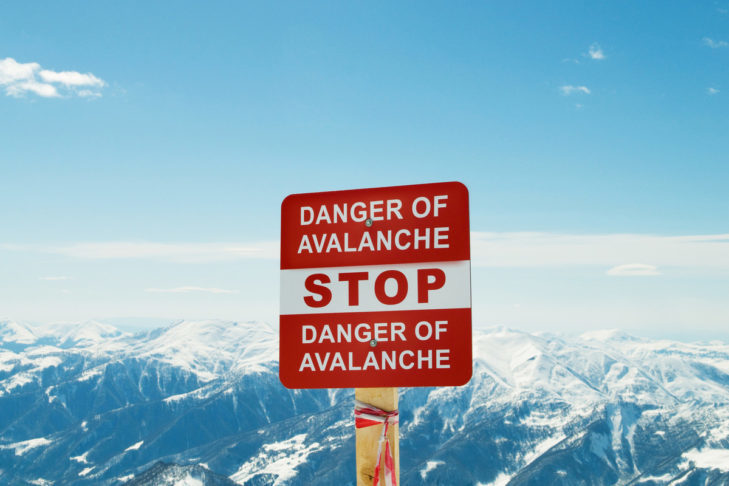Snow is a fascinating natural phenomenon: an overnight snowfall can cover the entire landscape with a glorious white layer the next morning. Skiers and snowboarders particularly appreciate snow, of course, as there would be no winter sports without it. But SnowTrex also knows that snow is sometimes unpredictable and harbors dangers. It is therefore all the more important to understand the phenomenon so that you can ski safely on the snow-covered slopes.
Why does it snow?
A lot of people believe snow is frozen water. It is, however, not that simple. Before it snows, a number of chemical and physical processes have to take place. It may not be magic, but it is no less impressive.
Snow starts off as water vapour. Water on earth, e.g. from lakes or rivers, rises into the air as steam due to heat, and eventually forms clouds. The higher the steam rises, the colder it becomes and the less pressure there is in the atmosphere. As a result, the water vapour molecules are very mobile and do not bind to each other. If a cloud is cold enough, i.e. around – 12 °C, the molecules are stored around smallest dust particles in the air. The molecules consist of two hydrogen atoms and one oxygen atom, which are at a certain angle to each other. A hexagon is always formed as a result when the molecules are placed around the particles. This is how snowflakes take their typical crystal form.
Water vapour molecules form at each of the hexagon’s corners until the cloud is too heavy to stay in the air and the molecules fall down as snowflakes.
The snow crystals that create these snowflakes have different forms, depending on weather, wind and temperature. There are in fact so many different options for individual crystal shapes that almost every snowflake is unique. They can, however, be classified according to their general shape.
But just because the snow crystals fall does not mean it is snowing in the mountains. For that, the air must be cold enough all the way down. This means that the temperatures must be at least 0 °C. The same applies to the snow remaining on the ground: Only if the soil cover has temperatures around freezing point or colder, the snow does not melt directly when it lands on the ground. If a lot of snow falls at once, and the snow still remains on the ground even though the soil cover may have temperatures up to 5 °C. This is because snowflakes lie on top of each other quickly and the snow mass is compressed in such a way that the soil cover cools down quickly enough.
Not all snow is the same
As diverse as the forms of snow crystals are, as diverse can the forms of snow and the type of snowfall be. This is particularly important for winter sports enthusiasts, because the various shapes and types of snow influence the pistes and, in part, demand specific skiing techniques.
Forms of snow
Fresh snow is new snow that just fell to the ground and where the crystals are still intact. If skiers ski on fresh snow and the snow is not levelled by snow groomers, the winter sports enthusiasts’ rutting turn into little hills on the pistes. These can be difficult and exhausting to handle for beginners.
If new snow has both a high air content and a low water content, it is called powder snow. Because powder snow is relatively dry, the individual snowflakes do not stick onto each other. Skiers downright glide through the snow, which is why skiing on powder snow almost feels like flying.
In Japan and Canada, powder snow is particularly fine and dry, which is why it is also called champagne powder. Many believe it is the best snow in the world. It is very rare in the Alpine region, as champagne powder requires little wind, very cold temperatures and little humidity. These conditions are more common in Japan and North America than they are in the Alps.
The opposite of dry powder snow is damp snow. Damp snow has, as the name suggests, a higher water content. This is why it also falls when the outside temperatures are warmer. The water makes the crystals adhere better to each other, the snow “sticks”. Therefore it is the ideal snow for snowball fights or for building snowmen. When skiing, however, damp snow means that you need more strength to move forward. You do not glide through the snow as easily as with powder snow.
If it is even warmer and the snow has an even higher water content than with damp snow, it is called wet snow or slushy snow. Winter sports enthusiasts also call slushy snow “breakbone snow”, because a lot of effort is required to ski through it. This is why wet snow requires a special skiing technique. You stay relatively upright and centred above the ski in order to be able to cushion possible hills well. If you ski on the edge, you glide better. In wet snow caution is always advised, because entire snow plates can come loose quickly and the danger of avalanche is particularly high.
Another special form of snow is crusted snow. This means that the upper layer of snow freezes, but the snow below that is still soft and dry. If the snow is old and forms a solid mass, this is called crusted snow. The icy layer requires a high level of skill on part of the winter sports enthusiasts. The movements must be soft and gentle so that the ice cover does not break and you do not fall. A good technique is to keep the skis close to each other and lean back far when skiing. This is how you keep your ski’s tips up and can ski safely down to the valley.
Slush is a not particularly stable mixture of snow lumps and water, which is also called depth hoar or sugar snow. It forms due to differences in temperature in the snow cover and is dangerous for skiers, because the skis can sink in without warning. This can also result in snow slabs, which are treacherous for winter sports enthusiasts.
Beyond that, there is firn. This is snow that is a year or more old. The special snow form is created when the finely branched ice crystals melt into larger, granular formations through repeated thawing and freezing. The larger the grains become, the more air disappears from the spaces between them, until finally impermeable firn ice is formed. Around eight meters of fresh snow develops into approximately one meter of firn. Under the increasing pressure of the overlying snow masses, firn ice eventually becomes glacier ice. This process takes several years!
Far away from ski areas, in the tropics and subtropics, there is also penitential snow. This snow is formed in the high mountain regions when the snow piles up to high mountains.
Density of snow
Depending on the form of snow, snow has a varying density. The drier the snow, the less dense it is:
- Fresh snow (dry, loose): 30 – 50 kg / m³
- Fresh snow (bound): 50 – 100 kg / m³
- Neuschnee (strongly bound): 100 – 200 kg / m³
- Old snow (dry): 200 – 400 kg / m³
- Old snow (damp-wet): 300 – 500 kg / m³
- Depth hoar: 150 – 300 kg / m³
- Firn: 500 – 800 kg / m³
Apart from these natural forms of snow, there is also artificial snow. In the ski areas it comes from snow cannons, when there is not enough natural snow for the winter sports enthusiasts in the skiing season. Water vapour and water droplets are brought together in highly compressed air and then come out of the cannon as snow.
Although artificial snow offers the possibility of skiing even with little snowfall, its production requires a lot of energy and water. Sometimes, as much energy is consumed in making artificial snow as in a city with 150,000 inhabitants. This is why artificial snow is criticised by environmentalists. In addition, winter sports enthusiasts have a higher risk of injury because artificial snow is more compact and thus harder. For better skiing, it is advisable to ride more on the edges so as not to slip so easily.
However, snow does not only remain on the ground in different forms, it also falls in different ways.
Types of snow
For example, snow cannot only fall as flakes. If snow falls from stratus clouds or high fog, it is called snow grains. In warmer temperatures, when snow mixes with more water, sleet comes down.Drifting snow occurs when strong wind whirls up the snow that has already fallen. When it snows at the same time, it is called snow flurry. A snowstorm is a combination of slowly sinking temperatures and strong winds.

Snowdrift occurs when wind whirls up the snow. Depending on how loose the snow is and how strong the wind is, this can have a strong influence on visibility conditions and balance when skiing. Snow banks, sometimes also called snow cornices, occur mainly on obstacles such as trees or fences, because snow is particularly loose here.
Overlooked danger: snow-covered trees
Trees may not only cause snow banks. Large amounts of snow on trees can also be dangerous for skiers in other aspects: there is a danger of avalanches.
If the trees are still small, high snow masses are no problem, as the trees are only pressed into the ground. The trees are not disturbed in their growth either. For larger trees, between three and five metres, the situation is different: If they were pressed down by a dense blanket of snow during the winter, they can no longer straighten up in spring and grow crooked. This not only damages the trees – the inclination towards the valley also favours snow slides and thus increases the danger of avalanches.

In order to be able to always ski safely, knowledge of the different types and forms of snow and the appropriate skiing techniques is very important. Caution is also advised for winter sports enthusiasts whenever it snows. Therefore, you should always check the avalanche report and the weather forecast before going out on the slopes, and make sure to avoid dangerous areas.If the snowfalls becomes too heavy while you are on the piste so that you cannot see anything anymore, you should go to the nearest mountain hut or down to the valley.
If this is not possible, winter sports enthusiasts should take a break until the weather improves. If you are well prepared and take care, you do not have to go completely without skiing when it snows. On the contrary: safe skiing in snowfall is great fun and a very special experience for every winter sports enthusiast.
Seven unusual facts about snow
Part of the fun can also be knowing a few unusual facts about snow.
1. Snow is an important source of drinking water
Snow is an important source of water, as up to 75 % of the earth’s fresh water occurs in snow and ice.
2. Snow is not white
Snow is not really white, it is colourless. But since the many crystals act like mirrors and reflect the white sunlight several times, snow looks white to our eyes.
3. Not every snow crystal is unique
Even though snow crystals are usually described as unique due to the multitude of possible shapes, this is not quite correct. Even if they are rare, scientists have already discovered identical crystals.
4. Snowfall can violate the law
In March 1992, the city of Syracuse, New York, passed a law declaring further snowfall that year illegal. However, the snow did not abide: two days later, it started snowing.
5. The fear of snow has a name
There are people who have a proper snow phobia. This disease is called Chionophobia (chiono being the Greek word for “snow”). This irrational fear is usually triggered by a childhood trauma, and sometimes it restricts people so much in their everyday lives that they do not stop outside the door in winter.
6. Not every snowflake is tiny
The largest ever measured snowflake was not tiny at all: it had a diameter of 38 cm.
7. Snowball fights can take on unexpected dimensions
On 12 January 2012, the world’s largest snowball fight ever took place in Seattle. It brought together 5,834 people.
Although snow as a physical and chemical phenomenon has been well researched, it does not diminish the fascination that the snowy splendour exerts on us. Especially in winter sports, snow is not only romantic, it is essential for skiing. However, it also holds dangers. This is why it is helpful to understand snow on the slopes in all its forms and types, in order to be say on the way – but also to enjoy it to the fullest.
FAQ about snow
What is snow?
Snow is formed from water vapour and forms at great heights. Water vapour molecules bind to form ice crystals and fall down.
Why does snow not always settle?
For snow to stay on the ground, either the ground cover must be 0°C, or a lot of snow must fall at once. If it is warmer or less snow falls, the snowflakes melt as soon as they land.
Is snow always the same?
No! Not only can the snow crystals take countless forms, the types and forms of snow can vary a lot as well. Snow can be dry and light, or sticky and wet. Depending on wind and weather, snow can be very different.
Why is wet snow more dangerous for skiers than powder snow?
Wet snow develops at warmer temperatures, is very moist and therefore sticks particularly well. In addition, warmer temperatures ensure that masses of snow can loosen easily. For skiers, this always means an increased risk of avalanches.
Why do skiers have to be familiar with snow?
Without snow, there would be no winter sports. Like every natural phenomenon, snow also holds risks and dangers for skiers. The better you know and understand them, the safer you are on the slopes.







